| |
ACD FAQ's

Some of the questions we frequently hear from people researching the breed:
|
|
Back To Top
What health concerns do ACDs have?
Please visit our ACD Health Concerns, Terms and Testing Information page for health information in the ACD.
|
Is the ACD an aggressive breed?
If the situation arises where they need to be, they can be. They are a tough breed, and are not a naturally social breed. This is a breed that is bred to bite things to make it MOVE, work all day long in the conditions of the australian outback, fend off snakes and crocodiles, and move rank cattle over vast distances - it takes one tough breed to do that! They are not for the faint of heart, not for the timid or wishy-washy owner who wants a dog that will just sit and watch TV with them and be a couch potato. If you want a breed that will greet every visitor to your home with tail and tongue wagging, you may want to think about a Golden Retriever. The cattle dog breed standard clearly says suspicious of strangers - they are that, and they will not hesitate to protect family, home and vehicle if they feel any are being threatened! This does not mean they are a naturally aggressive breed, as they are not, but if they feel they need to defend or protect, they will not hesitate to do so. This is why socialization is so vitally important with this breed - it doesn't mean they will become a golden retriever, which would not be proper for this breed, but it will help them better determine when aggression is warranted and when it is not.
|
Back To Top
How much activity and structure does an ACD really need?
A LOT! The ACD does indeed need a lot of activity, both physical and mental, and they need guidelines and structure in their daily lives. If you put your ACD in your back yard all day long with nothing to do, you should expect that your dog is destroying everything, and he won't stop barking, and what do you do with this monster of a dog that is totally out of control!
If you do not give your dog an outlet for all of their energy, they are going to find ways to vent that energy on their own - and don't expect to be happy with the activities THEY choose! The ACD is not like most other breeds, even herding breeds, they are more demanding and determined than most! All herding breeds are highly intelligent, high energy breeds - they have to be to do what they were bred to do. If you don't have a herd of livestock that they can move across your ranch all day long, then give them appropriate things to do as a substitute.
They NEED a job - it's not a cliche, it's not just something we say, it's fact. A tired cattle dog is a happy cattle dog!
| |
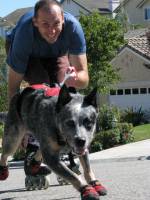
Lakota Chewy "Chewy"
An active ACD getting a great workout and having fun! |
|
Back To Top
How are ACDs with children?
ACDs are very protective, devoted and loving of their families. However.... it is very important to supervise and teach any dog how to behave around children. Small children are prone to
move quickly and erratically; they emit shrill sounds. These actions can stimulate a puppy's instinctive drive to
`heel'. Even play bites can be painful. What is play for the puppy may be frightening for the child.
The reverse is
also true; children must be carefully taught to treat a puppy with quiet kindness and gentleness. Do not leave
children in charge of your dog or vice-versa. Children should never be left unsupervised with dogs, regardless of what breed of dog!
It is up to you to make sure that your home is a suitable one for an ACD if you plan to introduce one to it. If your children are very young, you may want to wait till they are older to bring home your first ACD. That is nothing against an ACD or any other breed, but as a parent, I can say that small children take all the time you have and then some! A highly intelligent, thinking, doing breed like the ACD needs a lot of guidance to grow to be a great adult dog, so it is in the dog's best interest to be in a home where they have that attention ready to be given directly to them. |
|
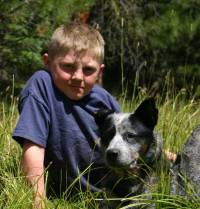
Multi HIT CH Hit N Heel A Kewl New Twist, HSAs "Megan", in her retirement home with her boy |
|
Back To Top
What is the difference between an Australian Cattle Dog and a Blue Heeler?
Australian Cattle Dogs have had several common nick-names through the years: blue heeler, red heeler, Hall's heeler, queensland heeler. These are terms used to describe a color/region and an action. When they are PUREBRED, the correct name for them is Australian Cattle Dog. If someone is referring to a "heeler" it could be a pure australian cattle dog as that has been a slang term for a cattle dog for years, however it could have any mix of other heeling breed mixed in as well. There's no way to be sure unless they are purebred and registered that they are not a cross breed of herding dogs.
|
Back To Top
Weren't ACDs originally dingoes?
Dingoes were used in the creation of the breed, but they were never entirely dingoes, no. Also, a red cattle dog is no more a dingo than a blue cattle dog. There is absolutely no difference between the colors other than the color.
|
Back To Top
Why do some ACDs have a tail, and some do not?
It is common to see cattle dogs that have been docked. You will run into heated debate as to rather or not a cattle dog needs its tail to properly work the stock. I have seen both docked dogs and dogs with natural tails work cattle, and I do believe that they work better with their tails on. Some believe that their tails get in the way, but that has not been my experience with this breed. The tail is usually flat out behind them while they are working, where their feet are usually not. I have run across sites that say "they are a dog, not a boat - they don't need a rutter". Well..........they don't NEED a rutter, but they do use it as a counterbalance, which is how this breed was developed to do. Think of it this way.....remove an arm at birth - you'll still get around just fine, and you'll learn to counterbalance yourself while moving without the arm, but just think how you could get around with both arms........NATURALLY.
Regardless of the debate - the fact remains: the breed standard states that the tail remain natural and intact. It very clearly indicates the length, flow, brush and carriage of the tail. So.....a tail they should have.
|
Back To Top
What are the acceptable ACD colors?
Blue / Blue Speckle / Blue Mottle
Usually always, but not required to be, with tan - this is NOT red - on the face, chest, legs, inner thighs.
Also may be with or without black markings in addition to the tan.
Red Speckle / Red Mottle
May or may not have red markings.
On red dogs, the color should be a clear red, meaning no blue or black hairs in the coat.
It is preferred not to have solid markings on the body, though it is acceptable.
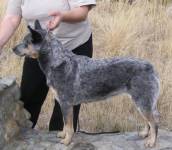
"Blue with tan"
(Lakotas Juniper Wind)
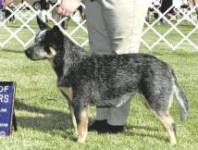
"Blue with black & tan"
(GCH CH Lakotas Turn It Up N Play It Loud)
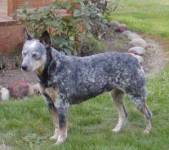
"Blue speckle with tan"
(Lakotas Mystic Dreamer)
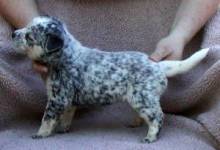
"Blue mottle with tan"
(Lakotas Mystic Storm Dreamer)
| | | |
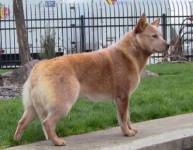
"Red speckle"
(GCH CH Lakotas Indian Summer)
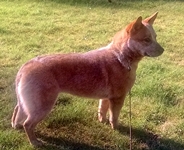
"Red speckle with red"
(CH Lakotas Rope The Northern Wind)
| |
Back To Top
I have heard that there is a temperament difference between the colors, is this true?
NO. not in the slightest regard.
We have heard all the theories - reds are supposedly more aggressive than blues, more wild than blues, or vise versa.
The only difference between the colors is just that - COLOR. Color has no effect on temperament whatsoever, regardless of how many weird stories you may hear from people who swear that the red ones are closer related to dingoes or whatever. It just is not so!
|
Back To Top
How do ACDs do with trainers?
Most trainers do NOT have a clue about cattle dogs. They say a dog is a dog, and that they know herding breeds or that they know ACDs specifically. If you are interested in going WITH your dog to a trainer, find out from your local cattle dog club who they recommend in your area. Someone who does not truly know this breed can do a lot of mental damage to your dog, and you may or may not be able to undo that.
If you are going to take your dog to a trainer, we recommend you go WITH the dog and go through the training right along with your dog so that A) you know what is going on and B) you are both on the same page with your goals.
|
Back To Top
What is NILIF?
NILIF stands for Noting In Life Is Free. The NILIF program is an accepted standard in dog training/behavior but it is not, and is not intended to be, a substitute for an in-person, professional evaluation of your dog's behavior. This technique is intended for dogs in good health and of sound mind and stable temperament.
Check out these links for further information:
www.k9deb.com/nilif.htm
www.greyhoundlist.org/nothing_is_free.htm
Back To Top
| |
| |







